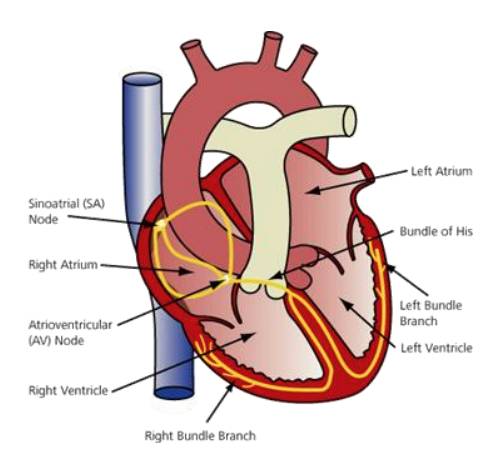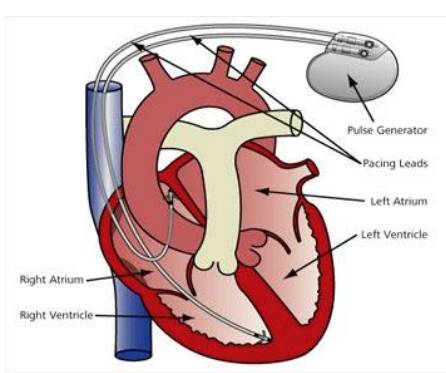Cardiac Angiography Unit Pacemaker Implant Pre-Procedure leaflet
Please note, this page is printable by selecting the normal print options on your computer.
Important points to remember
Please read this information book carefully, if you have any questions please bring these with you to your pre-assessment appointment.
• You should take all your normal medications except Warfarin, Apixaban, Dabigatran, Rivaroxaban and Edoxaban.
• If you take Warfarin, Apixaban, Edoxaban, Dabigatran or Rivaroxaban please phone the angio department on 01908 996539 and ask to speak to one of the nurses for advice, at least one week before your procedure.
• You may wish to postpone taking any ‘water tablets’ (diuretics) on the day of the procedure and take them after your procedure has been performed.
• Please bring all the medications you are taking to the hospital with you.
• If you are a diabetic please inform the nursing staff who can monitor your blood sugar levels whilst you are not eating and drinking
• Please do not eat anything on the day of your appointment unless the nurse or doctor tells you to. You may drink sips of water up to your procedure time.
• Your admission letter will give you details of where you will be admitted on the day of your pacemaker insertion
The morning of the test
We ask that your relatives/friends drop you off at Cardiology reception at the time of your appointment. Relatives / friends are not permitted into the day ward, but they will be contacted when the nurses are happy that you are fully recovered and ready to be picked up. On arrival please report to the Cardiology department at the rear of the hospital site where you will be able to park in the Cardiology patient ‘pay and display’ car park. It is important that you arrive on time in the morning.
You will be taken to the Day Ward in the Cardiac suite. This is a single sex unit. On arrival to the day ward you will be asked to change into a gown ready for your procedure. Bring a dressing gown and comfortable footwear. We advise that you leave all valuables at home. The nurse will check all your details and discuss the procedure with you. Antibiotics will be given to you before the procedure through a cannula in your arm and if the doctor feels it necessary maybe on discharge home.
Every effort is made to ensure your waiting time is kept to a minimum. Occasionally delays can occur; the nursing team will keep you informed of any changes.
The heart
The normal adult heart has a regular heartbeat which is within 50 and 100 beats a minute. The heart has four chambers as shown below. The heart has a natural pacemaker (sino-atrial node) this group of cells is on the right side of the heart and transmits electrical impulses across the two small chambers of the heart (atria). Another group of cells called the atrio-ventricular node (AV node) are positioned above the two large chambers of the heart (ventricles). As the electrical impulses pass from the AV node to the ventricles this causes them to contract – this is your heart beat.

What is a pacemaker?
A pacemaker is a small, battery powered device that is implanted permanently into the body. The pacemaker monitors the electrical impulses in the heart and, when needed, delivers electrical
stimuli to make the heartbeat (contract) in a normal rhythm.
When is it used?
A pacemaker is used when the heart beats too slowly (bradycardia) or has other abnormal rhythms (arrhythmias). In some cases, pacemakers are also used to treat symptoms of breathlessness from heart failure.
How does it work?
A pacemaker consists of a battery and electrical circuitry (pulse generator). The battery powers the pacemaker. The circuitry checks the heart rate and produces tiny electrical impulses that keep the heart beating at the correct pace. The pacemaker is connected to the heart by one to three insulated wires which attach directly to the chambers of the heart (the atria and ventricle).

Pacemakers are designed to meet the specific needs of each individual patient.
• Rate responsive pacemakers
These pacemakers may be programmed to increase or decrease your heart rate to match your activities (walking, running, resting)
• Single chambered pacemakers
These pacemakers use only one lead positioned into the right upper chamber (right atrium) or the right lower chamber (right ventricle).
• Dual chambered pacemakers
These pacemakers have two leads. One positioned in the right atrium and the other one in the right ventricle.
• These pacemakers have leads that may be placed in multiple positions in the right ventricle.
Your cardiologist is likely to have discussed reasons for this in advance. This procedure often takes more than 1 hour. If you already have a pacemaker you may be having your box (pulse generator) changed in order to replace the battery.
The procedure
The procedure is carried out in a specially designed room which is set up like an operating theatre. There will be a number of staff present throughout the procedure including a Cardiologist, Nurses, Cardiac Physiologists and Radiographers. There may be staff present undergoing training. You will be asked to walk from the Day Ward area into the Lab area, if you are unable to walk we
will provide a wheelchair or trolley. The procedure normally takes about 1 hour to perform, depending on which type of pacemaker you are having fitted or if the procedure is for a box change.
You will be awake throughout the procedure, but medication can be given to help you relax. Once inside the room you will be asked to lie on the X-ray table. An x-ray machine may take pictures during the procedure.
A local anaesthetic will be injected into the area where the doctor will make a small incision for the pacemaker. The pacing leads are entered into the heart this will be x-rayed during placement to ensure good positioning. At this point, the doctor tests the lead to see if this location is suitable. You will hear the team calling out numbers whilst testing the lead, this refers to the lowest amount of energy needed to stimulate your heart to beat, helping your doctor find the best position for the lead. This is called the threshold.
Once the leads are in position further X-rays will be taken, you may be asked to take deep breaths and cough vigorously while your doctor observes an X-ray of your heart. This is all to ensure
proper and secure placement of the leads. Once the leads are in position your doctor will plug these into the pacemaker and slip the pacemaker into the small pocket made beneath the skin of your upper chest. The pocket is closed with stitches to complete the procedure.
You will be monitored closely during the procedure, if you are having any discomfort please inform your nurse or doctor. You will then be taken back to the day ward.
After the procedure
When you return to the day ward your blood pressure and pulse will be checked by a nurse. A dressing may be applied over the pacemaker site and the nursing staff will observe this. Please inform the nursing staff if you are in any pain after the procedure. You will be offered something to eat and drink as soon as the nurse feels that you are ok. You will need a pacemaker check before you go home to see if the pacemaker function is correctly set for your needs and a further x-ray will be performed to check the position of the lead/s before discharge. You will need a relative or friend to collect you at discharge.
Are there any risks?
There are some risks associated with having a pacemaker inserted. These may include:
• Bleeding
• Infection
• Pneumothorax – this is when air gets into the lining of the lungs. If this occurs you may experience some shortness of breath and discomfort.
For some patients, having to lie still on the procedure table for the length of the procedure may cause some discomfort or pain. There may be other risks depending on your medical condition. Please discuss any concerns with the doctors or nursing staff before the procedure. You will be given more advice on the risks when you are discharged, however, if you experience any of these you will need to contact your GP.
Contact details:
Milton Keynes University Hospital NHS Foundation Trust
Cardiac Angiography Unit
Department of Cardiology
Milton Keynes Hospital
Standing Way
Milton Keynes
MK6 5AD
Cardiac Angiography Unit 01908 996539 (Monday to Friday 8am-4pm)
Cardiology ward/ Ward 17 01908 996419 (24hrs 7 days)
Cardiology Department Reception 01908 997197 (Monday to Friday 9am-5pm)
